 | E-mail to Birds Korea |
 | KWBS |
in the Region
 | The Oriental Bird Club |
 | BirdLife International (Asia) |
April
One of the very best birdwatching months! Cold days and nights (lowest day maxima of about 12°C) gradually warm through the month (reaching the low 20s°C by month’s end), and dry spells interspersed with 1-2 days of heavy rain and stormy conditions produce great birding towards month’s end.
Early in the month, late-migrating Hooded Crane move through while shorebird numbers and diversity start to build up. While the massive concentrations of shorebirds at Saemangeum are no longer to be found since seawall close there in 2006, internationally important concentrations of species like Great Knot and the Critically Endangered Spoon-billed Sandpiper and Nordmann's Greenshank can still be found at the adjacent Geum Estuary. Other ROK specialties include Chinese Egret and Black-faced Spoonbill, especially along the west coast. This latter species has a world population of only c. 2500! While early April sees species like Brown-headed Thrush and Japanese Robin in very small numbers (especially in the southwest and southeast), mid-April is often marked by the first large passerine arrivals and spring overshoots, with good counts possible of Blue-and-white, Narcissus and Yellow-rumped Flycatchers, and Tristram's and Yellow-browed Buntings. Late in the month, 100 or more species a day are possible on outer islands like Heuksan and Gageo in the far south, Eocheong and Weiyeon in the west, and Socheong and Baekryeong in the far northwest.
In more than one recent year, national rarities have included Pied Wheatear, Caspian Tern, Japanese Night Heron, Black-headed Bunting and Himalayan Swiftlet. Korean firsts in April since 2000 have included Ferruginous Flycatcher and Crag Martin (2002), Paddyfield Warbler on (2004), Claudia’s Leaf Warbler (2009) and Godlewski’s Bunting and Golden-crowned Sparrow (both in 2010).
Aphae Island, April 29
The visit to the southern tidal-flat was mostly in cloudy conditions with occasional rain showers. On arrival the high tide was still three hours ahead and this gave the option to have a closer look onto a small group of shorebirds, mainly Bar-tailed Godwit, a few Whimbrel and Mongolian Plover, one Red Knot and one Chinese Egret.
In the adjecent fields several Common Greenshank and c. 20 Little and Eastern Great Egret as well as a few Grey Heron were seen.
With running-in tide the number of birds increased immense: 400 Bar-tailed Godwit, 70 Grey Plover, 1 Pacific Golden Plover, 50 Whimbrel, 160 Ruddy Turnstone, 60 Great Knot, 30 Grey-tailed Tattler, 40 Terek Sandpiper (one with a yellow leg flag), 2 Curlew Sandpiper, 80 Mongolian Plover, 1500 Dunlin, c. 50 Red-necked Stint, small number of Kentish Plover and one Far-eastern Curlew.
Eventaully the tide washed all birds onto a concrete path which leads onto the tidal-flat, the tall birds at the end and the small ones at the front. In the mix of shorebirds c. 20 Little Tern tried to find a place; the wind and waves kept the birds in the back constantly shoving around so that the visit of 5 Chinese Egret was rather short. The small birds in the front seemed to had a much more relaxed time. In total eighteen leg-flagged birds were seen.









Busan, Taejongdae, April 29
This afternoon we finally had a break from almost two days of much-needed rain. The sky was overcast and the temperature cool. Birds were quieter than I expected but still it was a very nice time for a walk. Highlights of the afternoon include Ashy Minivet (2) singing and flying overhead, Asian Brown Flycatcher (1), Narcissus Flycatcher (3), Eastern Crowned Warbler (7) singing, Pale-legged Leaf Warbler (3), a very curious Japanese Bush Warbler, Grey-backed Thrush (1) singing, Pale Thrush (8) and personata Black-faced Bunting (1).
Baekryeong Island, April 27 - 28
Rain both days though with winds stubbornly from the north-east meant only a few new arrivals. Highlights on 27th included single Great Knot and Red-necked Stint; a half-dozen Grey-tailed Tattler; a group of 10+ simplex Japanese White-eye (still present there on the 28th, with a second flock of 5-10 in the far southwest too) and three or four Blue-and-white Flycatcher in the evening.
On 28th, the gardens in the east of the island held 15+ Chinese Grosbeak, single Japanese Waxwing and male Taiga Flycatcher, 2+ Asian Brown Flycatchers and more than a dozen Blue-and-White Flycatcher (with 26 of the latter species in total counted during the day in the east and southwest – all males of which were black-throated nominates, with one female showing an odd blue spot on the side of the head). Best of all there, however, was a singing Sakhalin Leaf Warbler (poorly recorded through the camera). The southwest of the island was much quieter in comparison, with most notable a single Yellow-bellied Tit and at least eight Red Crossbill.



Busan, April 26
With very little wind, no sign of showers, and a high of 23°C in the daily forecast, I was a little reluctant to get out birding on a busy weekend. Still, I couldn’t resist and ventured to the Nakdong. Before I could get to my usual walking path, Far Eastern Cisticola (19) could already be heard singing. They appeared to be in every direction and the reeds were bustling with their song and display. Highlights of the morning include Pallas’s Reed Bunting (15), Penduline Tit (14), and Stejneger’s Stonechat (3). At a small wetland area there were Eurasian Spoonbill (1), Common Snipe (3), Spot-billed Duck (11), Eurasian Wigeon (3), and a beautiful male Garganey (1).
Continuing on my walk, I heard some very aggressive-sounding snarls and hissing coming from the reeds. As I stopped to listen, two Amur Leopard Cats suddenly raced across the dusty path into the nearby bush. Seconds later, two Japanese Quail darted in the opposite direction, with one of the cats jumping mid-air after them, with its claws out grasping for a kill. Luckily, the quail escaped unharmed. I waited around quietly to see if there would be any more action, but both cat and quail disappeared into the reeds. I counted five Japanese Quail for the day.
I moved on to Myeongji tidal flat and found the tide to be slowly returning. In the distance, I observed Dunlin (300+), Mongolian Plover (12), Kentish Plover (5), Little-ringed Plover (11), Grey Plover (3), Sanderling (2), Common Greenshank (1), and a Black-faced Spoonbill (1).
Gwangju, April 26
Migration continues in and around Gwangju, with some interesting new arrivals. A day-hike around Mudeungsan resulted in approximately 30 species being seen, including some personal firsts (and a lifer) for the Gwangju area. Highlights of the 9hr hike included singing Asian Stubtails (9), Japanese Bush Warblers (14), and Eastern Crowned Warblers (2). The first Oriental Cuckoos (3) of the year were heard, as were newly arrived Siberian Blue Robins (3), a life bird for me. Varied Tits were observed feeding fledglings; White’s Thrush and Pale Thrush were in song. An impressive 6 Eurasian Wrens were also heard singing.
A recording of a Siberian Blue Robin song was taken; it is available here.
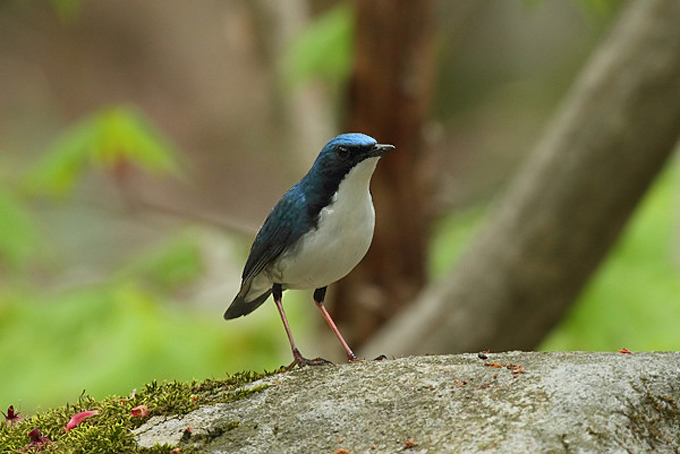
Weiyon Island, April 26
A day trip to Weiyon-do under overcast but unremarkable conditions. As expected, very few birds in evidence, perhaps partly due to multiple ongoing constructions. Hardly any birds worth mentioning for the first hour. Close to mid-day walking along the trail behind the ‘temple hill’, an extremely skulking warbler was encountered in the reeds/dwarf bamboos. Though no clear views were obtained, it was a small (size similar to a Dusky Warbler), rather plain buff overall (not much contrast on the upper part plumage), whiter underparts with a hint of yellowish on the flanks (based on fraction of second view as it flew through the vegetation). It stayed close to the ground, mostly walking on the dried vegetation in a ditch by the side of the trail. Its call was a high pitched monosyllabic ‘pick’ sound repeated a few time every few seconds. Expert opinion on possible ID is welcome.
2 Narcissus Flycatchers, 4 Blue-and-White Flycatchers (including a female without a tail!), half a dozen Eurasian Siskisn, similar number of Bramblings, 2 Great Spotted Woodpecker, 2 Asian Brown Flycatchers were also seen on the temple hill. There were about 2 dozen Olive-backed Pipits scattered over multiple locations and a Richards Pipit (which gave distant but good views) along with 3 Bull-headed Shrikes. There were 2 Chinese Grosbeaks, 1 Stejneger’s Stonechat. Buntings were represented by about 20 very vocal Little Buntings, 2 Yellow-throated Buntings, 1 Black-faced Bunting and 2 Yellow-browed Buntings (personal first of this spring). Only a few Pale Thrushes were observed. A few minutes before boarding the return ferry, a Eurasian Sparrowhawk being mobbed and chased by a mixed group of Barn Swallows and Buntings!
Baekryeong Island, April 25 - 26
After a day’s delay due to fog, the ferry departed Incheon for Baekryeong. The journey was smooth over calm seas, but my own mood (and no doubt that of many others’) was extraordinarily heavy. We left from the same building used by the Sewol’s doomed passengers only 10 days before. In the terminal now, the ferry timetable with Sewol’s name still; yellow ribbons on seats; post-it stickers sending love to lost friends and family; and televisions replaying that awful, surely avoidable sinking, half-watched by some of today’s passengers – a few of whom drank coffee while others had their early morning beers. Leaving the port, outside access was strictly forbidden while at sea - according to the safety announcement - but was nonetheless permitted once an hour or so for people to go out for a smoke. When will actions match words?
From inside, most numerous birds seen at sea were Black-tailed Gull (290) and Ancient Murrelet (59) with the highlight a Yellow-billed Loon in heavy moult, rowing away from our passing ship.
On Baekryeong itself, as a warm-up for this year’s Birdathon (still time for sponsors to support, please!..), a total of 112 species logged in the first 24 hours on the island, with less than a third of the island covered (all on foot). No flycatchers and few warblers were logged (likely because of the past week’s dry weather) and species of most note included a Black-faced Spoonbill in the main marsh at Hwadong (a key habitat now threatened by yet-more road construction: more on this to be posted later), single Chinese Blackbird and Japanese Waxwing, a flock of 57 Red-throated Pipit feeding in one ploughed field at Sagot, three Japanese Quail, and at least four Pechora Pipit overhead on the 26th (with the early date suggesting menzbieri).
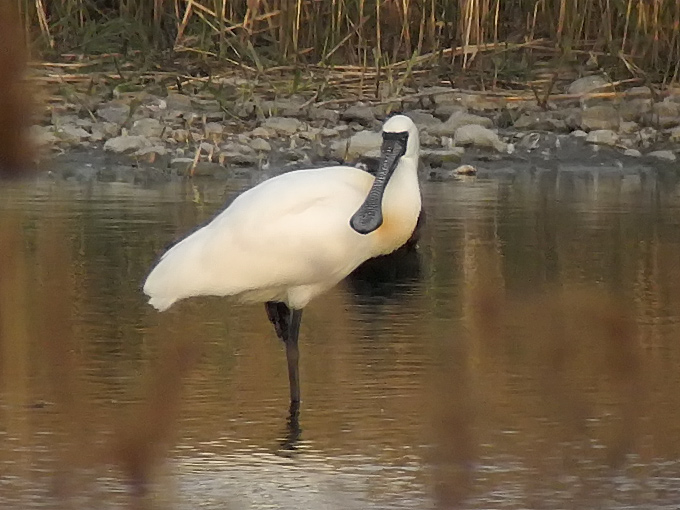
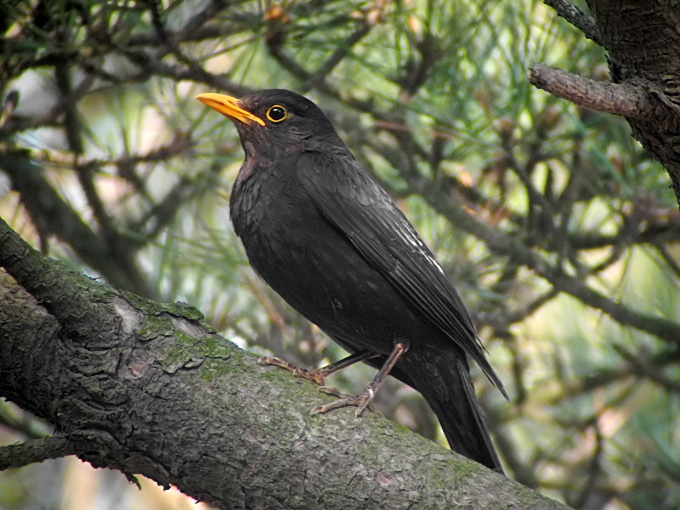
Gageo Island, April 16 - 22
Highlights from 6 days on Gageo.
Tuesday 22nd:
Tuesday before the boat added a Common Sandpiper. Fewer Yellow Bunting—2 seen. A Chinese Pond Heron in the main village looked like a different individual. From the boat: about 40 Murrelets (all looked like Ancients, but most were on the poor light side and distant) and 2 Streaked Shearwaters.
Monday 21th:
Monday added a Snipe, apparently a Swinhoe’s, and a Grey-tailed Tattler in the quarry. Blue-and-white Flycatchers were more apparent, probably due to sunny conditions (several were bathing) rather than increasing numbers. A singing Grey-backed Thrush below Little Hokkaido. At least by observation/hearing, Brown-headed Thrush continued to be the most common thrush on the island, with c. 40 noted during my stay. Several Black-crowned Night Herons in the concreted (and fishless) stream seemed to have recently arrived.


Sunday 20th:
On Sunday morning I spent some considerable time with the White-shouldered Starling. A Eastern Great Tit and a Siberian Weasel or jeokjaebi worked the same area—the latter, a non-native (probably arrived as stowaways on ships) apparently responsible for the eradication of Gageo’s snake population. A Eurasian Sparrowhawk drifted overhead. After Mr. Chakladar’s departure I made the trek to 2-gu: highlights were a calling Oriental Scops Owl, several cooing and finally 2 seen Black Wood Pigeons, chasing one another with their astonishing speed, several singing Eastern Crowned Warblers, a few calling White’s Thrushes, a distant flying group of apparent waxwings (species undetermined: 7 or 8 birds), an incongruously single Ashy Minivet above a ravine stream near Halfway Tree, several more Bramblings, and a pair of Varied Tits (one carrying green nesting material). 2-gu was very quiet, with a few Brown-headed Thrushes, a fly-by Oriental Pratincole over the ocean and another single Ashy Minivet. Back to the quarry by the end of the day, I came across 1 of S. C.’s 2 Little Whimbrels.


Saturday 19th:
Saturday began clear with a period of rain, then clear but somewhat cool. In the quarry, a Little Ringed Plover. A Temminck’s Stint crept around near the road to the trash tip. On the mossy slab, 3 Wood Sandpipers, a Kentish Plover and a Mongolian Plover. On the water, an Arctic Loon. Saturday mid-day marked the arrival of Subhojit Chakladar, who found (separately — see his report for details) some good birds including 2 Little Whimbrels and a female Citrine Wagtail.



Friday 18th:
Rain still, with light fog. Following are mostly new birds: 1 Cattle Egret. 1 Red-billed Starling. 1 Greater Short-toed Lark. A different Chestnut-eared Bunting. An unidentified Snipe. A single Chinese Pond Heron. A Whimbrel. A Yellow-breasted Bunting. Above the village, 4 Chestnut-cheeked, 7 Grey, 2 Red-billed, 2 Daurian and 1 White-shouldered Starling. At one point I could see 5 species of starling on the same telephone wire. Also: 3 Tristram’s Bunting, 2 Yellow-browed Bunting, and several more Brown-headed Thrushes and 2 more Grey Thrushes. In the harbor, 3 Great Crested Grebes.

Thursday 17th:
Thursday brought rain and fog. The afternoon (still raining) showed a clear but modest influx of migrants: perhaps a dozen new Red-throated Pipits, 20 new Olive-backed, an apparent (distant flight view) Richard’s Pipit, and several Bramblings. 2 Siberian Rubythroats allowed glimpses. A cracking male Black Redstart showed on the rocks beyond the trash tip; it may have been there the day before and remained elusive for the next few days. In the quarry: a Wryneck and a Grey Thrush .Some increase in Narcissus and Brown Flycatchers. A very bedraggled but apparently alert Great Knot near the harbor.
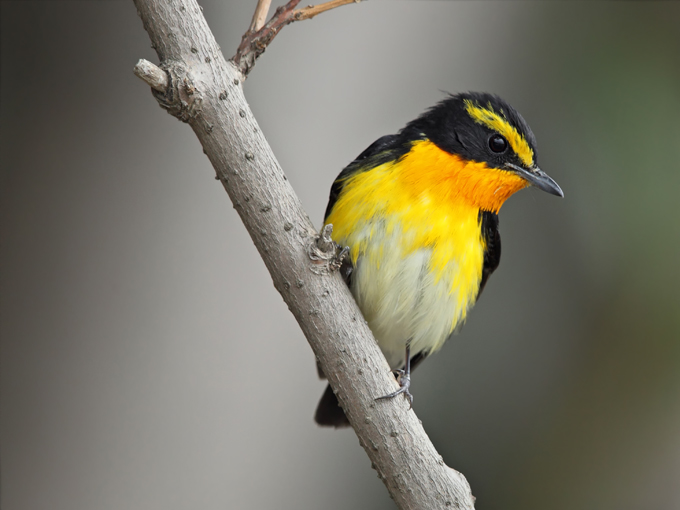
Wednesday 16th:
From the boat, about 40 Murrelets, some quite close. Most were (and as to be expected) Ancient; 3 looked to be Crested. Off the boat, a calling Yellow-browed Warbler, about 20 Olive-backed Pipits, a Japanese Quail, several Brown-headed Thrushes, calling Korean Bush Warblers, a single Pale-legged Leaf Warbler, a single Eastern Crowned Warbler, a calling Eurasian Hoopoe, 6 Narcissus Flycatchers, 1 Blue-and-white Flycatcher, 1 Chestnut-eared Bunting, 5 Black-faced Buntings, 6 Yellow Buntings, 7 Little Buntings, 8 Asian Brown Flycatchers, 4 Yellow-throated Buntings, a calling Siberian Rubythroat, 2 Pale Thrushes, 8 Japanese White-eyes, 3 Blue Rock Thrushes, several Great and Little Egrets, 6 Buff-bellied Pipits, 5 Red-throated Pipits, 3 Eastern Yellow,1 Grey and 2 White Wagtails, 2 Red-flanked Bluetails, a single Common Kingfisher, about 30 Barn Swallows, 2 Red-rumped Swallows, a Siberian Blue Robin, several Asian Stubtails, several Stejneger’s Stonechats, about a dozen Eurasian Siskins and a single Black-browed Reed Warbler. In the trees behind the main street: an unseen singing Chinese Grosbeak. Above the quarry: a Peregrine Falcon.




Nakdong, April 22
This evening, we enjoyed a short peaceful walk near the Nakdong as the sun set. As we were watching a Black Kite low-gliding across the sky, a Common Snipe (2) quickly flew past us and found a place to land near the water’s edge. This was a personal first for the season. A few Pallas’s Reed Bunting (4) seen in flight and we watched a couple more alongside Penduline Tit (3) in the reeds. Also in the reeds were Stejneger’s Stonechat (2) calling and Far Eastern Cisticola (1) singing.
At the park, there are two small bodies of water, which are sandy and not completely full of water. Usually, if there is not a lot of disturbance, we are able to find a few waterbirds. Today we found Eurasian Spoonbill (1),which has been observed there for at least 3 weeks. We also found Little-ringed Plover (2) and Gadwall (2), which have been observed there for at least 10 days now, and Eurasian Wigeon (3), which were seen last Saturday. Newcomers to the park include Wood Sandpiper (1) and a gorgeous Sharp-tailed Sandpiper (1). As our walk came to an end, we were excited to hear the song of an Oriental Reed Warbler (1), another personal first of the season and a reminder that summer is soon to come.
Gwangju, April 22
My wife and I made a brief visit to the mountains in East Gwangju at the Gakhwa reservoir. At least five Oriental Scops Owls were heard calling just before and after dusk. Also heard approximately 30 minutes after sundown was a single calling Grey Nightjar, a personal early record. Recordings of the scops owls were taken. On the walk home we were treated to a nice view of both Jupiter and Mars in the night sky.
Gageo Island, April 19 – 20
The regular weekend dash to Gageo to check out what the migration has brought forth. The sea crossing under overcast and increasingly windy conditions produced half a dozen Ancient Murrelet and 2 Streaked Shearwater. Following RN’s lead went straight to the garbage dump area in search of the Black Redstart spotted a couple of times in the last few days. An hours search failed to spot the bird but produced 2 Yellow Buntings and a female Citrine Wagtail instead, along with the other regulars in the area. The retreating tide revealed a Mongolian Plover and a Temminck’s Stint on the mossy slab. Walking around the main village, there was a feeling that the island has been taken over by Narcissus Flycatchers! But the gorgeous colors mean you never get tired of looking at them. Apart from them, there were good numbers of Blue-and-White Flycatchers, Asian Brown Flycatchers, Olive-backed Pipits, Red-throated Pipits along with Barn Swallows and a few Red-rumped Swallows in the sky. 3 Straited Heron were observed, including 1 coming off the sea just as the boat entered Gageo harbor. Walking up the quarry from the village produced good numbers of Pale and Brown-headed Thrush. The lower sections of the quarry had about 3 dozen Eurasian Siskins and 2 Little Curlew.
The next morning skies cleared out but very few birds of note were in evidence. Once again an extended stake-out for the redstart failed to produce any results. There were a few Eastern-crowned Warblers, Asian Stubtails in the neighborhood. Walking up the ‘pass’ produced 3 Tristram’s Bunting, 2 Rustic Bunting in breeding plumage and a group of very photogenic and confiding Japanese White-eyes. Following a call from RN, I rushed back to the new road construction just behind the village in time to see a White-shouldered Starling which feasted on berries and provided some nice photo opportunities. Just before leaving the island, a Greater Short-toed Lark was seen right outside the pension. A total of 54 species in the 24hr stay on the island.



Busan Area, April 19 – 20
I spent an enjoyable weekend birding with Mr. Jason Loghry and Mr. Jang Jiung at several locations in the Busan area. The weather turned against us, with both days having considerable wind out of the west, which kept many birds hunkered down. Nevertheless, we still managed to find some migrant species around.
Highlights included:
Peregrine Falcon, Pallas’s Reed Bunting, Far Eastern Cisticola, Chinese Penduline Tit and Eurasian Spoonbill along the Nakdonggang on the afternoon of April 19.
Stejneger’s Stonechat, Blue Rock Thrush, Grey-backed Thrush, Grey Thrush, Japanese Robin, Blue-and-white Flycatcher, and Narcissus Flycatcher at Taejongdae Park on the morning of April 20.
Black Kite, Asian Brown Flycatcher, Narcissus Flycatcher, Asian Stubtail, Eastern Crowned Warbler, Pale-legged Leaf Warbler, and a very probable Sakhalin Leaf Warbler at Igidae Park on the afternoon of April 20.
A total of 57 species were observed.





Yongjeong Island, April 20
Most noteworthy among the usual suspects massed on the southern mudflat were 139 Saunders's Gull, yawning and showing off their brilliant red gapes.
Also six Black-faced Spoonbill present- sadly their roost site has been completely bulldozed for a new development project.
Feeding frantically in the mud were up to 5000 Dunlin, a pretty sight as their flocks switched to and fro in the afternoon sunlight.


Igidae, East Busan, April 19
Starting early in the morning, conditions were feeling very much like spring. It was windy, the air was brisk, there were dozens of inchworms hanging from Red-billed threads throughout the woods and a thin layer of golden pollen was on the lens of my field glasses. Highlights of the morning include a Eurasian Sparrowhawk, Pale Thrush (9), Blue-and-white Flycatcher (7) including a female and some eating inchworms from the ground. Also observed and heard singing were Eastern Crowned Warbler (11), with two that appeared to be copulating. The behavior was aggressive and brief. I kept a distance and tried not to disturb the birds while I observed. Does this mean they might be nesting in the area?
Other highlights of the morning were Asian Brown Flycatcher (3), Japanese Waxwing (5), Narcissus Flycatcher (6) including 1 first summer bird and the bird considered to be owstoni, 2 Pale-legged Leaf Warbler calling, although I made special note because towards the end of the morning I heard the beginning verse of what sounded much like the song of a Sakhalin Leaf Warbler but wasn't the full song. I was unable to make to a recording or hear it more than once. Also, another nice surprise were Japanese Robin (2) singing in the same Sakhalin Valley area.







Igidae, East Busan, April 18
The first heavy rain of the spring in Busan fell from early afternoon on the 17th (when single Western Osprey and Eurasian Woodcock in Igidae were the highlights in three wet hours of observation) through to the early morning hours of the 18th. A full day (0630-1900) was therefore spent in the park on the 18th with overcast conditions clearing by mid-afternoon, though feeling cool (c. 15C) in occasionally moderate north-easterlies. As on April 18th 2013, counts of all birds heard and seen were made covering the two main streams, “Sakhalin Stream”, SK area (where construction continues) and back along the main road through the centre of the park. In addition, an hour (11:45-12:45) was spent watching the sea off from SK. In total, 65 species were logged, Names and order follow the newly-posted 2014 Birds Korea Checklist:
- Red-breasted Merganser Mergus serrator. Two.
- Common Pheasant Phasianus colchicus. A total of 14 heard and seen.
- Arctic Loon Gavia arctica. Two in intermediate plumage south, followed soon after by seven unidentified loons in non-breeding plumage further out also flying south.
- Streaked Shearwater Calonectris leucomelas. In total, 102 north in one hour, almost all in the first 20 minutes.
- Great Crested Grebe Podiceps cristatus. One in full breeding-plumage.
- Pacific Reef Heron Egretta sacra. One on the “usual” rocks near SK.
- Pelagic Cormorant Phalacrocorax pelagicus. Three Second Calendar-years.
- Temminck’s Cormorant Phalacrocorax capillatus. Twenty in various plumages off SK.
- Black Kite Milvus migrans. Two adults, calling frequently.
- Eastern Buzzard Buteo japonicus. One still.
- Little Ringed Plover Charadrius dubius. One on open ground in front of SK.
- Black-tailed Gull Larus crassirostris. The most numerous gull, with 10+ blogging over the sea and a further 20 roosting up on tetrapods and seawalls.
- Common Gull Larus canus. At least three off SK.
- Vega Gull Larus vegae. At least one off SK.
- Mongolian Gull Larus mongolicus. At least three, and possibly up to 10, off SK.
- Taimyr Gull Larus heuglini taimyrensis. One adult showing very worn upperwing coverts off SK.
- Pomarine Skua Stercorarius pomarinus. One poorly digiscoped pale morph adult with full spoon flying north over the sea off SK. There are rather few mainland records in spring.
- Murrelet Synthliboramphus sp. Three north off SK.
- Oriental Turtle Dove Streptopelia orientalis. Eleven heard or seen.
- Pacific Swift Apus pacificus. Approximately ten, most at SK.
- Japanese Pygmy Woodpecker Dendrocopos kizuki. Six.
- White-backed Woodpecker Dendrocopos leucotos. Excellent views of an adult male.
- Grey-headed Woodpecker Picus canus. One.
- Peregrine Falcon Falco peregrinus. Two or more probably three.
- Ashy Minivet Pericrocotus divaricatus. Five plus.
- Bull-headed Shrike Lanius bucephalus. One.
- Eurasian Jay Garrulus glandarius. At least eight.
- Eurasian Magpie Pica pica. At least 18, including several nest-building.
- Large-billed Crow Corvus macrorhynchos. Ten.
- Bohemian Waxwing Bombycilla garrulus. One still.
- Japanese Waxwing Bombycilla japonica. About 10 still present in the morning; not heard in the afternoon.
- Coal Tit Periparus ater. Four heard singing.
- Varied Tit Sittiparus varius. Only two.
- Marsh Tit Poecile palustris. Only one.
- Eastern Great Tit Parus minor. A total of 42 heard or seen.
- Brown-eared Bulbul Hypsipetes amaurotis. Hard to count accurately but 79 counted as heard or seen.
- Barn Swallow Hirundo rustica. Three singles.
- Korean Bush Warbler Horornis borealis. One in song.
- Asian Stubtail Urosphena squameiceps. Seven, all in the morning.
- Long-tailed Tit Aegithalos caudatus. Seventeen.
- Pallas’s Leaf Warbler Phylloscopus proregulus. One heard in song (as on almost the same data last year). This is a scarce species in the southeast of the country.
- Sakhalin Leaf Warbler Phylloscopus borealoides. A minimum of two: one or two in song (sound-recorded) and one calling. One additional bird heard calling briefly was either this species or more likely a Pale-legged (the call is subtly but distinctly different). This follows on from two or three heard here and one sound-recorded on April 17th and 18th 2013 (these among the first mainland records).
- Eastern Crowned Warbler Phylloscopus coronatus. A total of 11 heard or seen.
- Vinous-throated Parrotbill Sinosuthera webbiana. A total of 146 seen and heard (172 were counted on the same date here last year).
- Japanese White-eye Zosterops japonicus. Thirty-two.
- Goldcrest Regulus regulus. Five, including one in song.
- White’s Thrush Zoothera aurea. Six.
- Grey Thrush Turdus cardis. At least two adult males.
- Pale Thrush Turdus pallidus. Twenty-eight.
- Dusky Thrush Turdus eunomus. One at SK.
- Asian Brown Flycatcher Muscicapa latirostris. At last five together in “Sakhalin Stream”.
- Blue-and-White Flycatcher Cyanoptila cyanomelana. Nine in total, with seven nominate males (many of which were Second Calendar-years and several of which were singing) and two females.
- Siberian Blue Robin Larvivora cyane. One in song.
- Japanese Robin Larvivora akahige. One adult male briefly feeding on berries in a tree about 2m up.
- Narcissus Flycatcher Ficedula narcissina. Four male narcissina (including two singing and one obviously Second calendar-year individual) and one apparent Second calendar-year male owstoni. Tentative identification of this tricky individual was based on several features outlined in our online ID note (at: http://birdskorea.org/Birds/Identification/ID_Notes/BK-ID-Narcissus-Flycatchers-types.shtml ) including: (1) retention of much immature plumage; (2) yellow feathering of emergent supercilium apparently extending to base of bill; (3) lack of strong red-orange in throat feathering; (4) pale base to apparently deep-looking bill; and (5) large area of white on the wing, including what appeared to be a pale spur on the left side (unfortunately not digiscoped clearly). While narcissina occurs regularly on the mainland and on offshore islands during northward migration, owstoni is much less-often recorded / reported with perhaps all claims to date confined to islands in the west and southwest..
- Daurian Redstart Phoenicurus auroreus. Four.
- Blue Rock Thrush Monticola solitarius. Four.
- Eurasian Tree Sparrow Passer montanus. Found only around SK, where about 25 present.
- Grey Wagtail Motacilla cinerea. Two.
- White Wagtail Motacilla alba. One.
- Buff-bellied Pipit Anthus rubescens. One.
- Grey-capped Greenfinch Chloris sinica. Seven.
- Eurasian Siskin Spinus spinus. Only one heard (even though a few dozen were present earlier in the week).
- Tristram’s Bunting Emberiza tristrami. One.
- Yellow-throated Bunting Emberiza elegans. Eighteen in total.

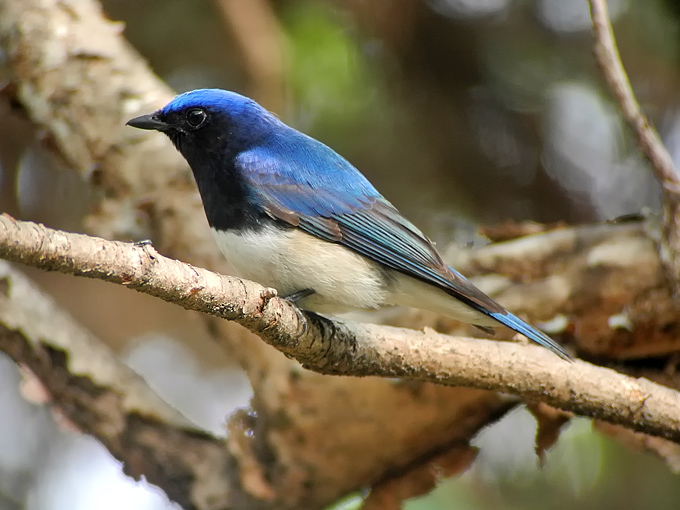
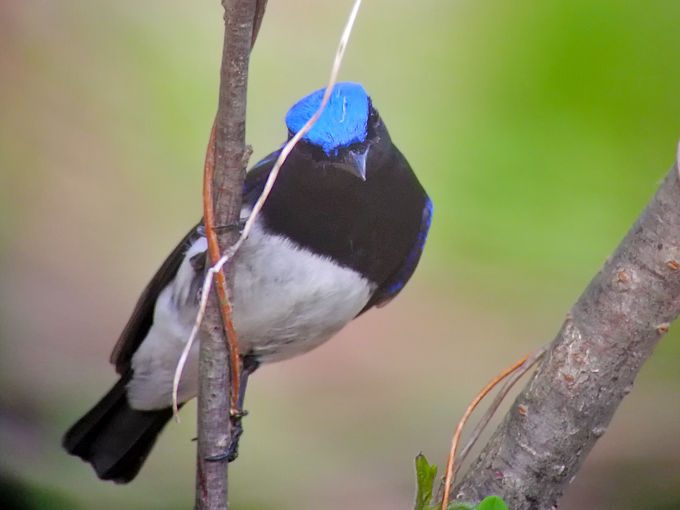





Mokpo Namhang Urban Wetland, April 18
The visit to the site in a grey morning with occasionally light rain showed not very many birds, but a good number of shorebird species on the natural tidal flat: 39 Bar-tailed Godwit (the number during the week varied between 21 and 51), today only green leg-flagged BNN was seen. Earlier this week also an individual with an orange engraved leg-flag and code 3V was seen two times on the site. This bird was banded in 2011 and was seen in Mokpo every year since banding (see: Flagrecords Mokpo Namhang Urban Wetland).
Other shorebirds seen were: 7 Whimbrek, c. 60 Dunlin, 4 Terek Sandpiper, 2 Great Knot, 2 Sharp-tailed Sandpiper, 2 Grey Plover, 1 Common Greenshank, 1 Common Sandpiper, 4 Little Ringed Plover, c. 20 Kentish Plover.
Several Grey Heron and 3 Little Egret were slowly wading through shallow waters while 3 Little Tern were active hunting for fish. Eastern Spotbilled Duck c. 50 and about 40 Eurasian Wigeon with only a handful Common Teal were largely on the water or resting on platforms. A few Black-tailed Gull and Black-headed Gull were also seen.

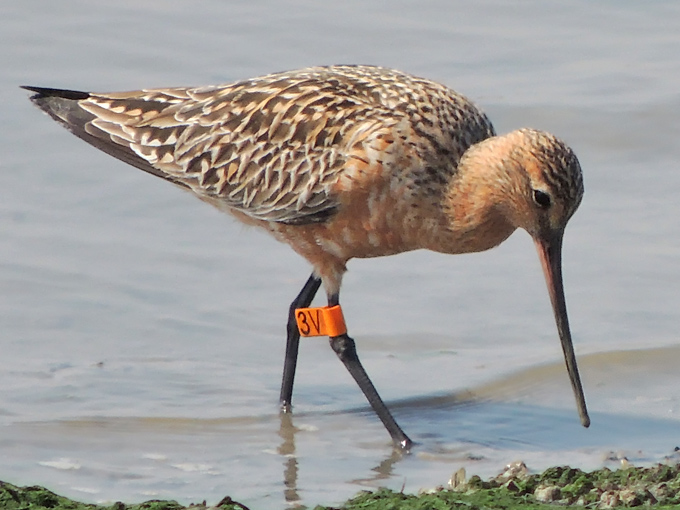

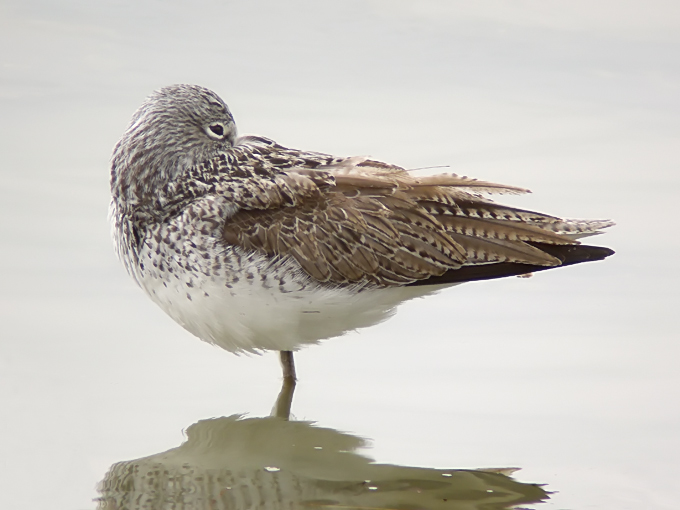





Gageo Island, April 13 -16
April 16:
A Tree Pipit was observed when I was birding at Haneul Park.
It was with an Olive-backed Pipit and I was able to make a direct comparison, its supercilium was unclear, nearly absent ear coverts, with very narrow streaking on its flanks.
Also, the color was relatively murky, giving a dirty impression. Alongside this bird, Siberian Rubythroat, Grey Thrush, and Chinese Blackbird were also recorded at a nearby small pine forest.
April 15:
I climbed Doksil Mountain to Shinseon Peak from the early morning. I was around the areas of 2-Gu village and the beach-side road where villagers are raising their goats.
There were a relatively high number of birds, and they were easy to find. When I moved to 1-Gu, I found a Grey Bush Chat at the grassland of Haneul Park.
Following the news from Mr. Go Kyeong-Nam, who I met on the island, I found a Thick-billed Warbler, Chestnut-flanked White-eye, and Eurasian Wryneck on the same day.
April 14:
Although, I was mainly climbing a mountain... there were lots of Asian Stubtail and thrushes, with the Black Woodpigeon singing at various places.
A female Ashy Minivet was observed on a beach-side road from Shinseon-bong to Hangri Village and a Greater Short-toed Lark when I was going to Seomdeung Peninsula.
April 13:
About 20 Streaked Sheawater were observed from the ferry going to Heuksan island. I started birding right away upon arrival. Interestingly, Narcissus Flycatcher were seen very often.
Species list:
- Great Crested Grebe Podiceps cristatus
- Streaked Shearwater Calonectris leucomelas
- Temminck’s Cormorant Phalacrocorax capillatus
- Great Egret Ardea modesta
- Little Egret Egretta garzetta
- Black-crowned Night Heron Nycticorax nycticorax
- Grey-faced Buzzard Butastur indicus
- Japanese Lesser Sparrowhawk Accipiter gularis
- Peregrine Falcon Falco peregrinus
- Green Sandpiper Tringa ochropus
- Wood Sandpiper Tringa glareola
- Black-tailed Gull Larus crassirostris
- Vega Gull Larus vegae
- Mongolian Gull *Larus mongolicus
- Black Wood Pigeon Columba janthina
- Oriental Turtle Dove Streptopelia orientalis
- Pacific Swift Apus pacificus
- Common Kingfisher Alcedo atthis
- Greater Short-toed Lark Calandrella brachydactyla
- Barn Swallow Hirundo rustica
- Eastern Yellow Wagtail Motacilla tschutschensis
- Grey Wagtail Motacilla cinerea
- White Wagtail Motacilla alba ocularis
- Black-backed Wagtail Motacilla alba
- Olive-backed Pipit Anthus hodgsoni
- Red-throated Pipit Anthus cervinus
- Buff-bellied Pipit Anthus rubescens
- Tree Pipit Anthus trivialis
- Ashy Minivet Pericrocotus divaricatus
- Brown-eared Bulbul Hypsipetes amaurotis
- Light-vented Bulbul Pycnonotus sinensis
- Siberian Rubythroat Calliope calliope
- Siberian Blue Robin Larvivora cyane
- Red-flanked Bluetail Tarsiger cyanurus
- Stejneger's Stonechat Phoenicurus auroreus
- Grey Bush Chat Saxicola ferreus
- Blue Rock Thrush Monticola solitarius
- White’s Thrush Zoothera aurea
- Grey Thrush Turdus cardis
- Blackbird Turdus merula
- Brown-headed Thrush Turdus chrysolaus
- Pale Thrush Turdus pallidus
- Dusky Thrush Turdus eunomus
- Korean Bush Warbler Horornis diphone
- Japanese Bush Warbler Horornis borealis
- Asian Stubtail Urosphena squameiceps
- Radde’s Warbler Phylloscopus schwarzi
- Eastern Crowned Willow Warbler Phylloscopus coronatus
- Asian Brown Flycatcher Muscicapa latirostris
- Narcissus Flycatcher Ficedula narcissina
- Blue-and-White Flycatcher Cyanoptila cyanomelana
- Eastern Great Tit Parus minor
- Varied Tit Sittiparus varius
- Japanese White-eye Zosterops japonicus
- Little Bunting Emberiza pusilla
- Yellow-browed Bunting Emberiza chrysophrys
- Rustic Bunting Emberiza rustica personata
- Yellow-throated Bunting Emberiza elegans
- Black-faced Bunting Emberiza spodocephala
- Brambling Coelebs montifringilla
- Oriental Greenfinch Chloris sinica
- Eurasian Siskin Spinus spinus
- White-cheeked Starling Spodiopsar cineraceus



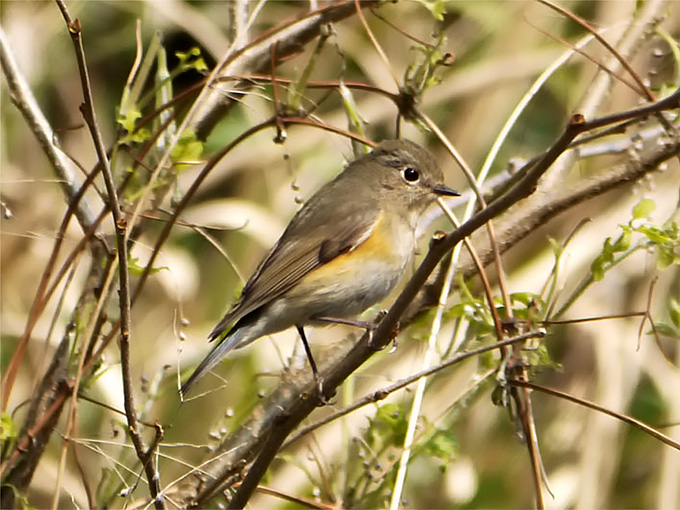


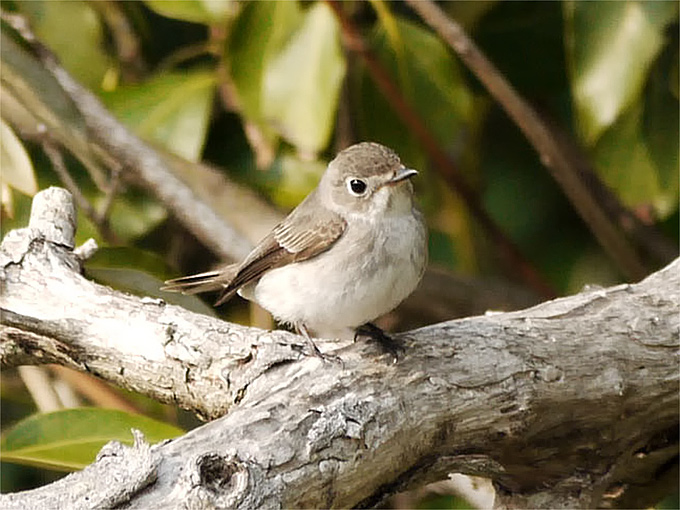

Igidae, East Busan, April 15
In warm afternoon sunshine (reaching 22°C), a few hours spent in woodland at Igidae. High numbers still of Brown-eared Bulbul (50+ seen), Vinous-throated Parrotbill (dozens) and Yellow-throated Bunting (tens, with several in song) and at least one White-backed Woodpecker. Other migrants more obviously on passage included a dozen or more singing Pale Thrush (only small numbers breed here) and at least four singing White’s Thrush, a dozen Barn Swallow, four Asian Stubtail, one Blue-and-White Flycatcher, one Grey Thrush, two Bohemian Waxwing and now at least 30 Japanese Waxwing.

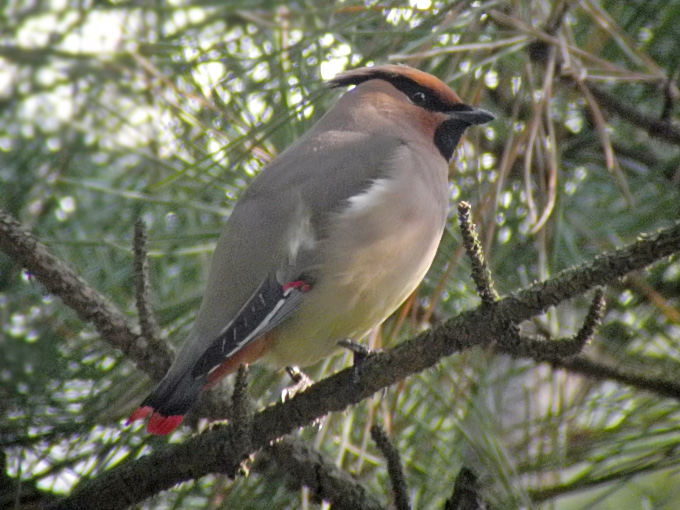

Busan, April 13
After a rainy morning, we were back at Igidae on Sunday afternoon where we again found Pacific Swift, Barn Swallow, several Brown-eared Bulbul, Pale Thrush, Grey Thrush, two gorgeous Narcissus Flycatcher, Japanese Waxwing (4; and 2 waxwing unidentified- possibly Bohemian heard), singing Blue Robin, Grey-capped Greenfinch, Eurasian Siskin, Goldcrest, singing Eastern Crowned Warbler, Japanese Bush Warbler, Asian Stubtail, and Red-flanked Bluetail.

Jeju, Seogwipo April 12-13
Seogwipo’s parks are buzzing with flycatchers! Cracking male Narcissus Flycatchers were spotted in two riverside parks, with six seen in total. Blue-and-white (5), Asian Brown (3), and Dark-sided (1) Flycatchers were also seen gorging themselves on insects. Also notable in these parks was a freshly-marked Eastern Crowned Warbler, and a Striated Heron on a familiar patch of stream (where I’ve seen Striated Herons overwintering in the past, but not this past winter). A presumably escaped Muscovy Duck was also seen here, with a head and bill structure strongly recalling a Mandarin Duck.
In my neighbourhood, small groups of Ashy Minivets have been heard twice more in the past week, with a single bird spotted circling aimlessly around the area for several days.


Busan, April 12
At dawn, we visited Yongdo looking for migrants. The sky was overcast and there were occasional showers. At the park we visited, there were fewer people than usual in the morning, which made for a pleasant walk birding. Highlights of the morning include great views of Japanese Robin (2), Stejneger's Stonechat (7), Black-faced Bunting including personata (6), Japanese Bush Warbler (3), Brown-headed Thrush (1), Pale Thrush (5), White's Thrush (3), Grey Thrush (1), Winter Wren (1), Red-flanked Bluetail (3), and Olive-backed Pipit (4), and both Japanese Waxwing and Asian Stubtail (1) singing.
In the afternoon, we headed to one of the eco parks along the Nakdong River. We were very pleased to find several more Stejneger's Stonechat (10+), Common Reed Bunting, Pallas's Reed Bunting, Penduline Tit, Far Eastern Cisticola (3), Japanese Bush Warbler, White Wagtail (lugens and leucopsis), Gadwall (9), Eurasian Spoonbill (1), Little Ringed Plover (2), Barn Swallow, with the highlight of the afternoon being a distant Bluethroat, possible first record for Busan?

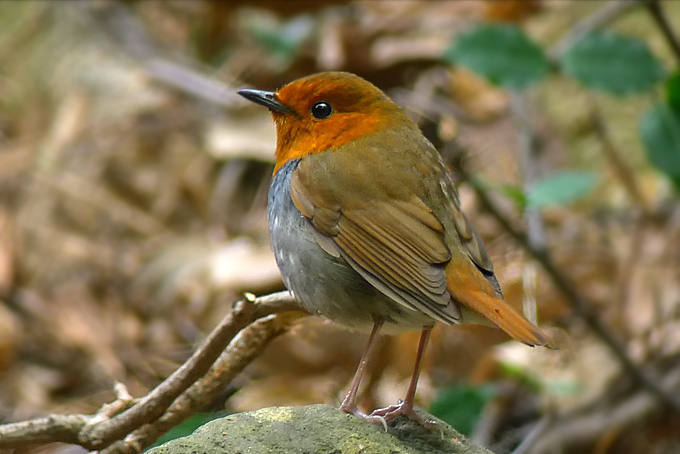


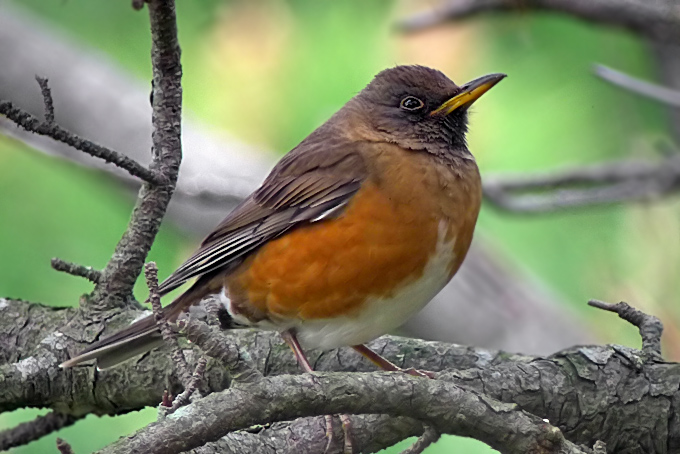
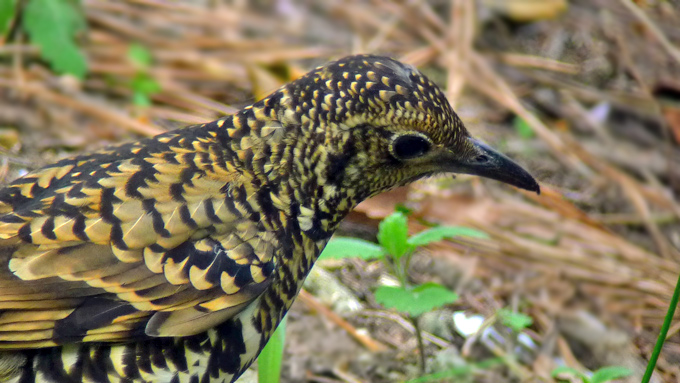

Busan, April 11
With only a few hours of afternoon light remaining, we set off to Igidae for a short walk. At the park, we were happy to find Pacific Swift (12) flying overhead right away. We had nice views of a stunning Blue-and-white Flycatcher (1), we encountered both male and female Grey Thrush (3), singing White's Thrush (3), Pale Thrush, Japanese Waxwing (2), Brambling, and singing Ashy Minivet.
Jeju, Mara-do, April 11
- Black-tailed Gull Larus crassirostris
- Ancient Murrelet Synthliboramphus antiques; two from the ferry
- Pacific Swift Apus Pacificus
- Eurasian Magpie Pica pica
- Great Tit Parus major
- Far Eastern Skylark Alauda japonica; several remain
- Barn Swallow Hirundo Rustica
- Japanese Bush Warbler Horornis diphone
- Japanese White-eye Zosterops japonicus
- White’s Thrush Zoothera aurea; one remains in the woods
- Grey Thush Turdus cardis; two males in the woods, one female on the rocks
- Pale Thrush Turdus pallidus
- Brown-headed Thrush Turdus chrysolaus; three in the woods
- Red-flanked Bluetail Tarsiger cyanurus; still a dozen females
- Stejneger’s Stonechat Saxicola stejnegeri
- Blue Rock Thrush Monticola solitaries
- Eurasian Tree Sparrow Passer montanus
- White Wagtail Motacilla alba
- Olive-backed Pipit Anthus hodgsoni; two on the rocks
- Grey-capped Greenfinch Chloris sinica
- Yellow-throated Bunting Emberiza elegans
Mokpo Namhang Urban Wetland, April 8
While passing the wetland in the morning short after high-tide a short stop was made to look for shorebirds. While the water, the floating platforms and most of the already free mud-flat areas were populated with Eastern Spot-billed Duck (c. 80), Eurasian Wigeon (c. 40), Eurasian Teal (c. 15), a handful of Gadwall and a flock of c. 40-50 Black-headed Gull mixed with a few Black-tailed Gull, in one corner 4 Bar-tailed Godwit, 9 Kentish Plover and 3 Dunlin were found. On one platform also seen one Great Cormorant, one Grey Heron and one Common Gull.
The infilling of the area P2 is operated at a high pace and so large areas are disturbed.
From distance looked at the area P3 showed a large flock of c. 300 larger Gulls, most likely like the days before Black-tailed and Vega.
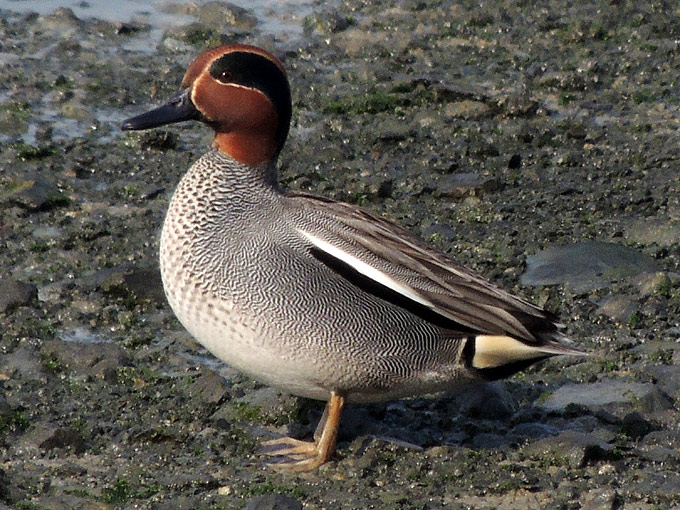


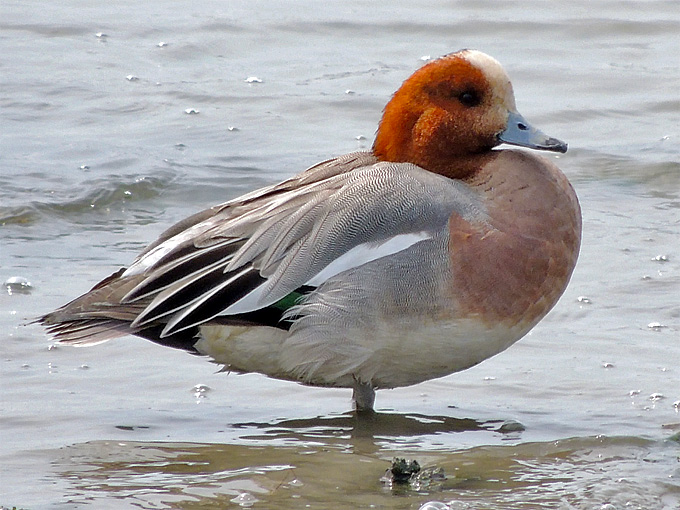






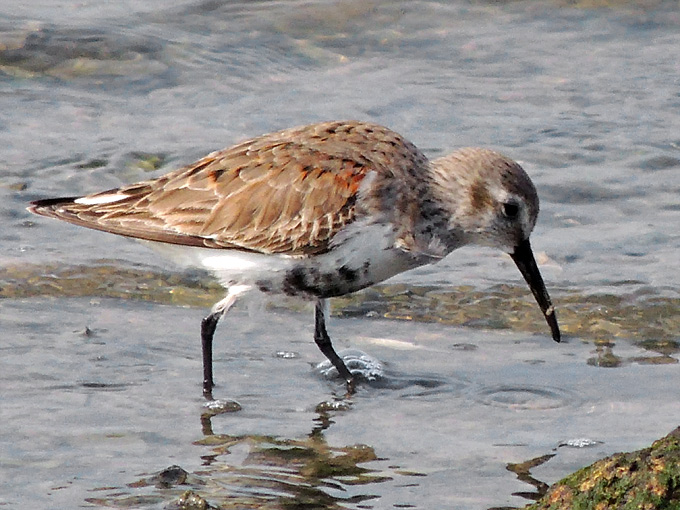

Mara-do and southwest coast, Jeju, April 6
Mara-do:
- Streaked Shearwater Calonectris leucomelas; one seen from the ferry
- Bar-tailed Godwit Limosa lapponica; two groups of roughly 10 seen heading towards Jeju
- Red-necked Phalarope Phalaropus fulicarius; 11 from the ferry between Mara and Gapa
- Black-tailed Gull Larus crassirostris
- Pacific Swift Apus Pacificus
- Eurasian Magpie Pica pica
- Great Tit Parus major
- Far Eastern Skylark Alauda japonica
- Barn Swallow Hirundo Rustica
- Japanese Bush Warbler Horornis diphone
- Japanese White-eye Zosterops japonicus
- Pale Thrush Turdus pallidus
- Brown-headed Thrush Turdus chrysolaus; several skulking in the woods
- Dusky Thrush Turdus eunomus
- Red-flanked Bluetail Tarsiger cyanurus; at least 20, mostly females
- Stejneger’s Stonechat Saxicola stejnegeri; numbers up to almost a dozen
- Blue Rock Thrush Monticola solitarius
- White Wagtail Motacilla alba
- Buff-bellied Pipit Anthus rubescens
- Brambling Fringilla montifringilla; the most numerous migrant on Mara, over 40 seen
- Grey-capped Greenfinch Chloris sinica
- Yellow-throated Bunting Emberiza elegans
Back on southwestern Jeju, I encountered groups of 12-20 Red-flanked Bluetails at 4 different patches of coastal woods. There were more males in the mix compared to Mara, and they were all feeding on sunny paths at forest edges. Also notable on ‘mainland Jeju, one Japanese Quail, and a group of shorebirds made up of nine Kentish Plover, two Dunlin, and one Red-necked Stint. Nearby, another Brown-headed Thrush was heard, and a White’s Thrush and personata Black-faced Bunting were seen.
On Saturday April 5th, in spite of a full day of birding in the hills, the most notable birds were encountered before I got out of bed - two groups of Ashy Minivets flew past my window during the early morning, heading towards Halla Mountain.

Yongdo, April 5
We went to Taejongdae in the early morning looking for migrants. Many birds were vocalizing, but mostly tits, many being Eastern Great. We enjoyed nice views of Pale Thrush (6+) and Grey Wagtail (4). We also heard a Blue-and-white Flycatcher singing beautifully. Away from Taejongdae but on Yongdo, we found Red-flanked Bluetail (3), a Dusky Thrush, Barn Swallows in flight and watched a flock of 100+ Eurasian Siskin from our apartment window for almost the entire afternoon. Although nothing surprising, it’s exciting to know birds are on the move.
Geum Estuary & Saemangeum, April 2 - 3
A quick visit to Saemangeum for research by one of the UK’s leading environmental journalists / writers Mike McCarthy (e.g. Independent journalist and author of the wonderful book “Say Goodbye to the Cuckoo”) was memorable for the company, conversation and also contrast between the natural abundance of the tidal-flats in Seocheon (Geum Estuary) and the decay of Saemangeum with all of its vast dead-scape of grass, concrete and rust.





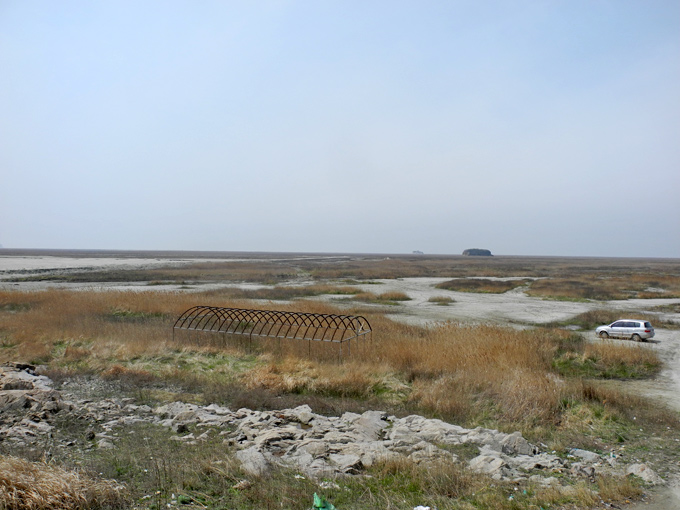

At low tide at the Geum barrage, a Common Starling (personally, a species encountered more frequently this spring than in any previous year) was the highlight, along with a scattering of Far Eastern Curlew. Bird life was much more abundant on the once-again-threatened Seocheon tidal-flats, with a high-tide roost there of c.13,000 shorebirds containing 2,000 Great Knot (globally Vulnerable), 2,500 Far Eastern Curlew (globally Vulnerable), 3,000 Dunlin, 500 Grey Plover and 5,000(+) Bar-tailed Godwits. Within the Bar-tailed flock, one menzbieri was detected in among the crowds of spring-plumaged baueri and also one striking leucistic bird: does anyone in New Zealand or Australia know this individual from the boreal winter? Also present there were 20+ Saunders’s Gull (globally Vulnerable) and at least four Swan Goose (globally Endangered).
We found many fewer birds in Saemangeum (where most time was spent along the outer seawall, visiting the various roadside “parks”, and at Simpo, in between the increasingly-canalized Dongjin and Mangyeung rivers). There were a few trucks road-building on former tidal-flats, but there appeared to be less construction activity than in most other parts of the country. Most of the tidal-flats are now covered in reeds and other grasses – a vast area populated more by Far Eastern Cisticola (dozens heard in song) than any “city of the future”. The only shorebirds we found were 40-45 Far Eastern Oystercatcher, a dozen roosting Far Eastern Curlew and a small squadron of Kentish Plover. More numerous were Great Cormorants (200+) and especially Greater Scaup with a single raft of 1,900 (fringed loosely by c. 15 breeding-plumaged Black-necked Grebe) out near the seawall. In among the scaup, a few smaller, darker-backed males seen at range, and one smallish-looking female caught wing-flapping – showing obvious contrast on the upperwing: Lesser Scaup or variation within Greater? Other birding highlight was a group of three Bohemian Waxwing seen dropping in at Simpo from up-high.




Birds Korea 1108 Ho, 3 Dong, Samick Tower Apt., 148-22, Namcheon-Dong, Su-Young-Gu
Busan, 618-762 Republic of Korea





